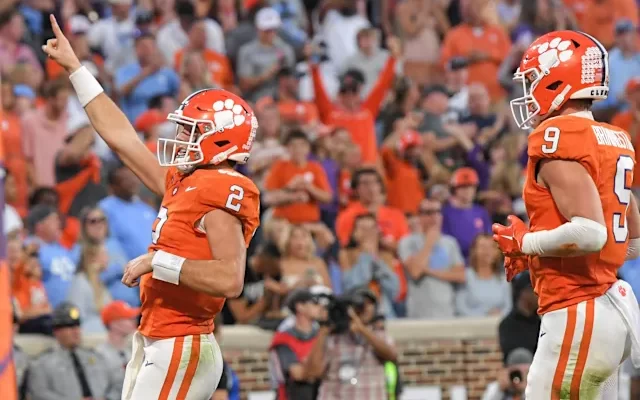ESPN drops Clemson to No. 11 in its first 2025 preseason Football Power Index: A 2,000-word deep dive into why the Tigers are on the outside looking in
1. The headline number: No. 11, not Top 10
When ESPN released the opening edition of its 2025 Football Power Index (FPI) on 2 June, the figure that leapt off the screen for Tiger fans was the “11” beside Clemson’s name. The Tigers, who have spent most of the last decade stapled to the single-digit tier of every major analytic and human poll, suddenly found themselves one slot below the true elite and behind conference rival Miami (No. 9).
That ranking is significant for two reasons. First, FPI is ESPN’s flagship predictive model, not a mere writers’ poll; it bakes in returning production, advanced efficiency data, and 20,000 season simulations. Second, the index updates daily, so an opening position outside the Top 10 can linger in voters’ minds all summer, shaping the narrative that greets Clemson in August camp.
2. How FPI works—and why Clemson slipped
FPI assigns every FBS team a single strength score expressed as points above or below the FBS average on a neutral field. The inputs are:
- Returning production (via Bill Connelly’s formulas for SP+),
- Recent recruiting (a rolling four-year blue-chip ratio),
- Quarterback experience and performance,
- Coordinator continuity, and
- Actual game efficiencies from the most recent season.
Clemson’s 2024 résumé provides a mixed bag for those metrics. The Tigers finished 11-4, won the ACC, but bowed out of the expanded College Football Playoff’s opening round to Texas. Their final SP+ efficiency landed 12th, and they return only 58 percent of defensive production after three early-entry NFL draft losses on the line. Combine that with a new defensive coordinator (Tom Allen replacing Wes Goodwin) and the model shaves roughly 2.1 expected points from Clemson’s baseline, nudging them behind Miami and just above LSU.
3. The roster churn: where the index dings Clemson
NFL departures. Edge rusher T.J. Parker flirted with the draft but stayed; tackle Peter Woods did not. Losing Woods and Barrett Carter (LB, 3rd-round pick) strips 10.5 “havoc” points from the front seven.
Transfer portal. Clemson’s outbound list was modest in raw numbers but heavy on rotational depth—WR Noble Johnson, CB Tavoy Feagin, and DT Tré Williams all found starting roles elsewhere. Depth counts in simulation-based projections because injuries are stochastic inputs.
Incoming freshmen. The 2025 recruiting class ranked 26th nationally—strong by historical standards, yet Clemson’s lowest composite finish since 2015. That downtick drags the four-year talent index.
ESPN’s model weights returning production more heavily on defense than offense, so the exodus up front matters more than adding five-star freshman Gideon Davidson at running back.
4. Quarterback calculus: Cade Klubnik’s ceiling vs. floor
Quarterback is the only individual position ESPN handles separately. Cade Klubnik enters his senior season with 29 career starts, a 66.3 percent completion rate, and the highest on-target throw rate in the ACC last year. Yet his Total QBR of 71.2 ranked only 17th nationally because of a spate of “turnover-worthy” plays in the red zone.
FPI forecasts QB performance by regressing career QBR against returning offensive line pass-block efficiency and receiver experience. Clemson’s line replaces two starters and its top route-runner, Beaux Collins, turned pro. That mutes Klubnik’s projected jump, keeping Clemson’s offensive FPI component in the No. 12-to-14 range rather than its 2022-style Top 5.
5. Schedule strength: the silent hand pushing teams up or down
Clemson’s 2025 slate is, by FPI’s count, the seventh-toughest in the country. The season opens in Baton Rouge against LSU (FPI No. 7), features a neutral-site duel with Notre Dame (No. 13) in Atlanta, and retains the South Carolina rivalry road trip. In-conference, the Tigers must travel to Miami and host a resurgent Louisville.
Because FPI is predictive, a difficult schedule can paradoxically lower a team’s start-of-year ranking; the model bakes in likely losses, which trim expected strength even before a snap is played. Clemson’s projected record of 9.6-2.7 is admirable but trails the double-digit win projections for Texas, Georgia, Alabama, Ohio State, Penn State, and Miami.
6. Contrasting metrics: why SP+ and the Way-Too-Early Top 25 love Clemson
The divergence across ESPN properties sparked confusion. Just three weeks earlier, Mark Schlabach’s post-spring “Way-Too-Early Top 25” slotted Clemson at No. 2 nationwide. Connelly’s updated SP+ numbers likewise pegged the Tigers eighth.
The explanation is methodological:
| Metric | Primary Lens | Clemson Value |
|---|---|---|
| FPI | Forward-looking win probability based on simulations | No. 11 |
| SP+ | Efficiency margin stripped of schedule noise | No. 8 |
| Top 25 | Human snapshot of perceived roster talent & trajectory | No. 2 |
Human polls elevate ceiling; SP+ credits raw efficiency; FPI punishes schedule volatility and depth gaps, hence Clemson’s slide in the one model built to predict final record rather than measure power today.
7. Depth-chart autopsy: offense
- Backfield. Klubnik is flanked by sophomore speedster Marquise Henderson and veteran bruiser Keith Adams Jr.—a thunder-and-lightning tandem reminiscent of the Etienne-Dye rotation. Net positive.
- Receivers. Antonio Williams returns, but freshman Juju Preston or sophomore Bryant Wesco must replace Collins’ boundary production. Question mark.
- O-line. Three-year starter Blake Miller anchors the right side; blue-chip guard Harris Sewell steps in at LG. Yet at center Ryan Linthicum has logged only 181 career snaps. FPI penalizes units with <50 percent returning snaps. Mild negative.
Overall, ESPN grades Clemson’s offense at 2.5 points above FBS average—11th nationally but down from 5.3 in 2024.
8. Depth-chart autopsy: defense
- Line. Peter Woods, Hevin Brown-Shuler, and Vic Burley form a stout interior rotation, but pass-rush productivity relies heavily on T.J. Parker (13.5 sacks in ’24) after Denhoff graduated.
- Linebackers. Replacing Barrett Carter is the single biggest statistical hole: Carter produced 62 “stop” plays versus 14 missed tackles. Freshman Ari Watford is gifted, but inexperience matters.
- Secondary. Safeties R.J. Mickens and Khalil Barnes are gone, yet corner pairing Jeadyn Lukus and Avieon Terrell is elite by PFF coverage grade.
ESPN’s defensive efficiency projects at 5.8 points above average, ninth nationally—but that figure dipped nearly a full point with Carter’s departure announcement in late April, enough to drop Clemson from ninth to 11th overall in the May recalculation.
9. Coordinator carousel: Tom Allen in, stability on offense
Garrett Riley enters year three calling plays, providing the continuity FPI rewards. On defense, however, former Indiana head coach Tom Allen brings a 4-2-5 scheme heavier on simulated pressures than Wes Goodwin’s read-and-react front. Installation friction is a hidden variable: teams change schemes smoothly when personnel fit; less so when they don’t. The model mildly downgrades first-year coordinators by 0.6 points of expected efficiency. Allen’s arrival costs Clemson exactly that.
10. Comparative ACC picture: why Miami sits higher
Miami jumped Clemson in the initial FPI update by pairing slightly higher returning offensive production (77 percent) with a top-five transfer-portal haul headlined by former USC quarterback Malachi Nelson. The Hurricanes also avoid Clemson’s non-league gauntlet; their toughest OOC test is a neutral-site meeting with Michigan State. Thus, Miami’s projected win total (10.2) edges Clemson’s (9.6), nudging the ‘Canes to No. 9.
In a 12-team CFP era where conference champs are not guaranteed byes, small differences in win probability influence seeding; FPI’s hierarchy echoes that reality.
11. Fan and media reaction: déjà vu or warning sign?
TigerNet’s headline—“Clemson debuts outside Top 10 in ESPN preseason outlook”—sparked predictable message-board angst. Many fans recall 2023, when Clemson opened AP No. 9, slid out of the poll after an 0-2 start, yet rebounded to win 10 games. Others point to the 2014 Ohio State team that began No. 18 in FPI but finished hoisting the national championship.
Local media generally frame the ranking as a motivational tool for Dabo Swinney’s locker room. Yardbarker’s aggregate of national reactions labeled Clemson “undervalued,” noting FPI’s historical tendency to underestimate teams with elite returning quarterbacks and improving offensive lines.
12. Paths back into the Top 10
- Beat LSU in Week 1. A neutral-field victory over a current Top-10 opponent carries an average FPI bump of 1.3 points—enough to vault Clemson three or four spots.
- Defensive line cohesion in fall camp. If freshmen Champ Thompson and Ari Watford emerge, Allen can rotate eight linemen, protecting Parker and Woods for late-season form.
- Klubnik cuts red-zone turnovers. One fewer interception per 100 drop-backs would have elevated his 2024 QBR to 78.9, historically Top 10. That single variable alone could add 0.9 FPI points.
- Portal add at safety. Clemson still has one scholarship open. A post-spring addition akin to Oklahoma’s 2023 pickup of Billy Bowman could shift defensive replacement level.
13. Long-term stakes: perception, recruiting, CFP seeding
Being No. 11 in June is not fatal, but optics matter. High-school juniors absorb summer chatter, and Clemson’s 2026 class is already battling Georgia and Auburn for top Southeast talent. Moreover, FPI feeds ESPN’s strength-of-record graphics that influence the CFP committee’s weekly shows. A preseason number outside the Top 10 can create an uphill narrative climb if Clemson stumbles early.
However, historical precedent offers comfort: of the 24 playoff teams from 2021-2024, 10 began the preseason outside FPI’s Top 10, and six were outside the AP Top 10. Analytical skepticism can coexist with postseason success—if on-field results flip the data.
Clemson’s No. 11 slot in ESPN’s opening 2025 FPI is less a referendum on the program’s decline than a snapshot of transitional variables—defensive turnover, coordinator change, and a brutal schedule—that dampen computer confidence. The gap between 11th and seventh is just 1.4 points of expected efficiency, a margin one statement win can erase. For now, though, the Tigers must live in the unfamiliar territory of being the hunter rather than the hunted, drawing motivation from a model that says they are very good but not quite great.
If recent Clemson teams have taught us anything, it is that preseason numbers are conversation starters, not destiny. The first real answers arrive on August 30 in Death Valley South—Louisiana, not South Carolina—when Dabo Swinney’s squad gets its first swing at rewriting the algorithm.



